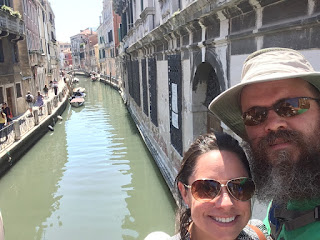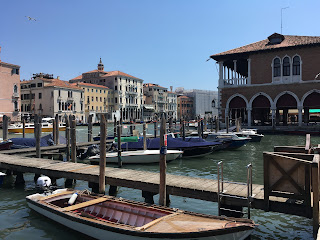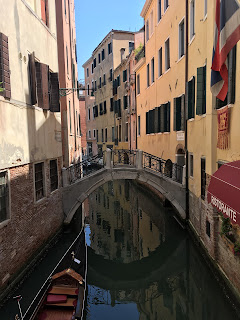We were determined to go to
Venice today, both to escape the heat and see the city
before it's underwater.
Research suggested that the train strike was 9 AM to 5 PM, but that the bus strike was 5:30 PM to 9:30 PM, which made this plan tricky but feasible.
Our Airbnb host said something like "some of the trains will probably be running, but there could be delays", which wasn't
super reassuring.
We caught the bus over to the train station around 10 AM. Per the woman at the ticket counter, the only train running was the high-speed train from Milan to Venice (which also stops in Verona), so we could at least get to our destination.
We inquired about round trip tickets, and she asked when we wanted to return. We countered with "What are the choices?"... she hesitated, then came back with "well, we're not sure what's going to happen". So we got one-way tickets, wondering if perhaps we'd be stranded in Venice. I think we had 7 minutes to find the train.
All of the regional trains were sitting idle at the platforms. After 9 AM, the trains simply stopped at whatever the next station happened to be. There were people milling about on the platforms, perhaps caught unaware.
The high-speed train was lovely. According to the display, we were traveling at 180 kph (~112 mph), and the train leaned into the curves.
At every station where the train stopped en route to Venice, all of the other trains sat idle at the platforms. It was an odd sight.
The trip was ~75 minutes of peace, rocketing almost silently through vineyards, orchards, and cornfields. Approaching the end, the tracks paralleled the highway that goes to the edge of Venice; we were glad we had decided not to drive, as traffic was backed up for miles.
Stepping out of the train station, we were confronted by the
Grand Canal and a busy plaza. It was bright, sunny, and hot, but still much cooler than Verona. I think it was "only" around 90° F.
Without having much of a plan, we crossed over the canal and started exploring.
Almost immediately, we decided to get away from the Grand Canal and its crowded... sidewalks(?), by turning down some side road and crossing another canal.
The smaller side canals were quite peaceful, as the motorboats seemed to stay in the Grand Canal.
Small squares (called
campos, according to the internet) are tucked between buildings, scattered around the city. The capped well in the center is an old rainwater cistern, per the article about Venice sinking that's linked at the top of this post.
Rather quickly, we discovered that aimless wandering doesn't work in Venice, because many of the streets dead-end at the water.
To avoid getting stuck and having to backtrack, we started following signs (sometimes arrows painted on walls, sometimes actual signs) towards
Piazza San Marco and/or
Rialto Bridge.
It wasn't that we necessarily wanted to see San Marco, or enjoyed the crowded route, but it was a reliable way to avoid getting lost in the maze.
We stopped to admire the canals each time we crossed a footbridge over one of them.
In some of these shots, it's an artifact of the camera lens that makes the buildings look crooked, but in a few places, it looked like they were actually leaning.
At every crossing, there were boats (in various states of repair) along the sides of the canals. It was impressive to watch some of them maneuver around corners and under the low bridges.
We may have done some window shopping while wandering along the narrow streets. For the discerning Lego collector, Venice has its own locally repackaged knockoffs "composed of original Lego pieces".
As we neared Rialto Bridge, we ended up back on one of the wider streets, heading to the Grand Canal.
It was easy to see why this canal is in the list of top tourist attractions in the city. We walked along it, towards the bridge, passing through the Rialto Market as the fish stands were cleaning up and closing for lunch break.
In case you don't read Italian (or have Google Translate) and can't figure out what "equina" means, there's a helpful picture painted on the window of this butcher.
After a solid hour of meandering, we finally reached Rialto Bridge, and crossed back over the Grand Canal.
After crossing the canal, we strolled along the waterfront for a while, still heading generally in the direction of San Marco Piazza.
Back in the maze of narrow streets, we crossed other small canals with the crowds of people heading to the square.
It was around 1 PM, and we were entering an area that seemed to have lots of restaurants, so we were on the lookout for promising lunch prospects as we strolled.
We deviated from the marked route to San Marco, to escape the crowds, but kept following small groups of people who seemed to know where they were going.
These tiny
sotoportegos were scattered around the city, but I could never tell if they led through to another street, to a courtyard, or something else entirely. If the ceilings had been more than 5 feet high, it would have been (more) tempting.
Having forgotten that random turns were not productive, we strayed from the main thoroughfare in search of a restaurant that was less crowded/touristy.
Again, we dead-ended at a canal. This time, it was the parcel delivery boat dock, unloading Amazon packages.
Back on the "main" street, we chose a restaurant and sat down for a light lunch with a side of air conditioning.
After lunch, we continued to the waterfront, at the start (or end?) or the Grand Canal, only a few turns from the wide open
Adriatic Sea.
I believe that's the
Basilica di Santa Maria della Salute, a 17th-century church, in the background.
Many of the buildings along the canal were in need of some TLC, and a few of them were even receiving it.
The docks in front of San Marco Piazza were a scene of floating chaos, as boats jostled each other, horns blared, and drivers shouted at each other in angry Italian. In the background, the
Church of San Giorgio Maggiore keeps a watchful eye on the situation.
The waterfront there, and the piazza itself, were bustling with activity on this beautiful Wednesday afternoon. Judging by the ferry and taxi traffic, many people skip the lovely stroll through the city and go directly to the piazza.
There were also boat tours of all shapes and sizes leaving from the San Marco waterfront.
We opted to skip the crowded piazza for now, and circle back to it later after wandering farther along the waterfront.
The canal behind
Doge's Palace was apparently the gondola expressway into the interior of the San Marco district. That's the (inaccurately named?)
Bridge of Sighs, in the center.
Along the waterfront, hordes of tourists and street vendors impeded our eastern advance.
My least favorite, by far, are the people who try to carry umbrellas through large crowds, risking poking others in the face because they can't be bothered with sunscreen.
Looking up the next canal, we were surprised to see the tower of this church (
San Giorgio dei Greci) leaning out over the water. A quick Google search suggests that the lean is
part of its claim to fame.
As we moved away from San Marco Piazza, the crowd thinned dramatically. We were about 2 miles from the train station, and almost 2 hours into our tour, so we decided to head inland.
After picking a promising-looking alley, we found ourselves in front of the
Venetian Arsenal.
Unable to continue northward, we turned and followed a canal, heading back towards San Marco Piazza.
To avoid getting lost, we loosely followed the flow of other groups who looked confident in their direction choices.
I stopped at every fountain we encountered, to soak my hat with water in an attempt to keep cool.
Many of the campos had these public fountains, which were often surrounded by a crowd filling their water bottles. Others had (limited) seating in the shade, which was always occupied.
We couldn't decide if the gondola rides were worth pursuing, or an overpriced tourist trap. Or both. Plenty of people had clearly decided it was worth it. I think the price was per-boat-ride, regardless of the passenger count, so the math made more sense for groups of 4 to 6.
It was obvious when we were nearing San Marco Piazza again, as the streets gradually got more crowded.
In the piazza, nobody was interested in sitting at the tables in the hot sun.
Hundreds of people were interested in standing in line in the hot sun to get into the basilica, however.
After seeing everything in the piazza, we slipped out a side exit to avoid the crowds and start meandering back through the city, eventually heading for the train station.
Instead of following the hordes back to the Rialto Bridge, we bypassed it and circled around north of the Grand Canal, keeping in the shade where possible, along a side canal.
Just a few blocks away from the main thoroughfare, out of the commercial area, Venice was nearly a ghost town. It isn't hard to avoid the crowds, as long as one is willing to do one's own wayfinding.
Unfortunately, the angle of the sun and layout of the streets conspired to keep us in the sun for the last mile or so. It was after 4 PM by the time we started seeing signs pointing us toward the
ferrovia.
Back at the train station, we were happy to discover the high-speed train was still running, so we acquired some tickets and were on the train back to Verona before 5 PM.
This time, the windows were clean enough to get some pictures of the countryside as it flew by the window.
We were back in Verona around 6 PM, just in time for the buses to stop running.
It looked like maaaaaaybe some buses were running, but they turned out to be the suburban routes, which didn't help us.
The bus platforms were full of confused passengers and striking workers, who were carrying flags.
We really wanted to go back to the Airbnb for a shower and to drop off our bags. Faced with walking a mile and a half back to the apartment, and then having to walk again to go find dinner, we instead opted to walk a mile to down/old-town Verona.
The plan was to explore Verona a bit, eat dinner downtown somewhere, and then take the bus back to the apartment after 9:30 PM.
The little bit of research we had done suggested the
Arena and
Castelvecchio were the two highlights, so we walked (slowly) in that direction. It was nearly 100° F and still quite sunny, even at 6 PM.
Castelvecchio ("Old Castle", where "old" means 14th century) is a beautiful castle that overlooks the
Adige river.
We peeked inside the courtyard, which now houses a museum. It was still open, but we weren't in the mood for a museum.
Instead, we crossed the
bridge, stopping in the center to admire the setting sun over the river.
The ramparts offered merciful shade as we gazed out over the water.
There was a wide spot in the middle, with an elevated section on each side that was accessible via stairs.
We noticed that there was another bridge, not too far down the river, so we could continue across to the far side, walk along that bank, and then return to old town without going too far out of the way.
As we made it across, a group of kayakers passed under the bridge. Also, there were people walking down by the river, and it looked very inviting.
We found the stairs leading down to the river, and I walked around in the cold water for a few minutes. The water wasn't very deep on this side, but the current was notable.
After resting for 10 minutes or so, we continued our walk along the river. From above, we could see a large school of fish holding position in the water. I'm no expert, but they look like trout to me.
A mere 5-minute walk along the river, then we crossed back to old town and headed towards the arena.
It was almost 7:30, and the arena was bathed in sunlight. Well-dressed people milled about, heading for a show inside the structure.
My favorite part of this pano is the food delivery bicycle that got consumed in the middle.
For our entire walk in Verona up until this point, the city had seemed deserted. On our lazy walking tour of downtown, we found all of the tourists crowded into a few pedestrian shopping streets that were paved with marble.
The
Piazza delle Erbe (market square), in particular, was bustling with activity; vendors were still hawking wares, and the restaurants were just opening so the outdoor seating was filling in.
I think this is city hall, with the tower, originally built in the 12th century (per Wikipedia).
We concluded our walking tour at that square, and from there sought out a restaurant that was recommended in the guide book.
Five minutes from Piazza delle Erbe, we found
Osteria da Ugo down a quiet side street.
I wasn't familiar with the distinction between the different restaurant types (
osteria,
trattoria, ristorante, etc.), so the concept of the osteria was new to me. It's less formal than a trattoria, apparently, which was good because we weren't quite dressed for fine dining and had been out accumulating a travel patina all day.
It was a fairly simple menu and a very slow pace. We started with wine and cheese, served with some local jams and honey. I had a glass of local Lugana, Sabrina probably had Chianti.
We both had pasta again, which was exceptionally good.
After dinner, we walked back to the arena to see it lit up at night. The sounds of an opera were clearly audible from outside, and probably for a block in every direction.
By then, it was approaching 10 PM and the buses had resumed normal service.
We hopped on a night bus just down the road from the arena, and rode it back to a neighborhood by our Airbnb.
Tomorrow, we're leaving Verona and taking the (very) scenic route back to Milan, where we'll return the rental car and stay in a hotel by the airport. Along the way, we plan to stop in a few cities for short visits, because the forecast is for 100°+ F again.
Everything after "return the rental car" is theoretical at this point, because there's an airport strike planned for Friday. We've called the airline several times by now, and they've finally assured us our flight will not be affected. Whether it is or not, we have to return the car.
Worst case, we spend an extra night in Milan, I guess. Never a dull moment.








































































































































